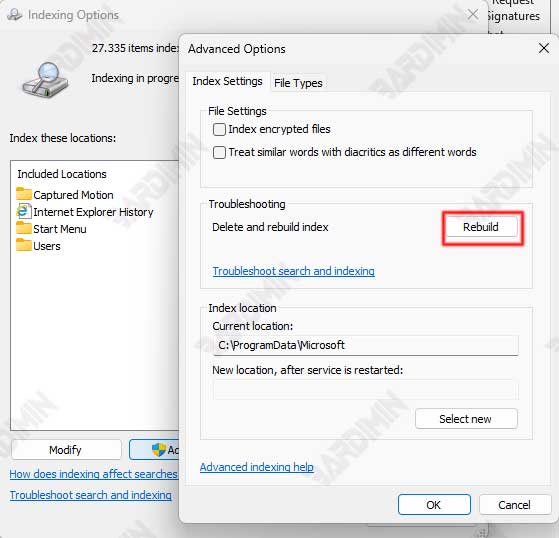2. Rebuild Search Index
Indexing databases can be corrupted due to:
- Improper shutdown
- Corrupt system files
- Conflicts after Windows updates
With a rebuild, Windows recreates the search database from scratch.
How to Rebuild Search Index:
- Press Win + S → type Indexing Options → open it from the search results.
- Select the tab Advanced → click Rebuild in the Troubleshooting section.
- Wait for the process to complete. Progress can be seen in the notification area (the Windows Search icon on the taskbar). The time depends on the number of files (it can be 10 minutes to a few hours).

If the rebuild fails, try disabling indexing for a specific folder (for example, a folder with a corrupt file). Make sure the C: drive has enough storage space (min. 500MB free space).
As a quick alternative, you can use PowerShell to force a rebuild:
Stop-Service -Name “Windows Search”
Remove-Item -Path “C:\ProgramData\Microsoft\Search\Data\Applications\Windows\” -Recurse -Force
Start-Service -Name “Windows Search”Rebuilding the index doesn’t delete your files, it just resets the search database. After a rebuild, the search may be temporarily slow until indexing is complete.
3. Repair System Files with DISM & SFC
Problems with Windows system files can cause File Explorer Search to fail to work. Windows built-in tools, such as System File Checker (SFC) and Deployment Image Servicing and Management (DISM), can repair corrupt or missing system files.
Steps to Repair System Files:
1. Open the Command Prompt as an Admin:
- Press Win + X → select Terminal (Admin) or Command Prompt (Admin).
- If you’re using PowerShell, make sure Admin mode is enabled.
2. Run SFC (System File Checker):
sfc /scannowThis process will scan and repair corrupted system files. Wait for it to finish (it can take 15-30 minutes).
Possible Outcomes:
- “Windows Resource Protection did not find any integrity violations.”→ No problem.
- “Windows Resource Protection found corrupt files and successfully repaired them.” → Corrupted files have been fixed.
- “Windows Resource Protection found corrupt files but was unable to fix some of them.” → Continue to DISM.
3. Run DISM (Optional, if SFC fails):
dism /online /cleanup-image /restorehealthDISM fixes the Windows Image that is the source of system files. Make sure your internet connection is stable because DISM may need to download components from Windows Update.
If the DISM error occurs, try the following command before running it again:
dism /online /cleanup-image /startcomponentcleanup4. Disable/Enable Windows Search Again
Sometimes, Windows Search Service gets stuck in an error state. By disabling and reactivating it, we allow the system to reset the service configuration.
Steps:
- Press Win + R → type services.msc → Enter.
- Search for Windows Search by scrolling down or typing directly in the search field.
- Disable Service:
- Right-click → Stop.
- Right-click → Properties → change Startup type to Disabled.
- Click Apply → OK.
- Restart the PC to make sure all related processes Windows Search, have completely stopped.
- Reactivate the Service:
- After the reboot, reopen services.msc.
- Right-click Windows Search → Properties → change Startup type to Automatic.
- Click Start → Apply → OK.
If the service fails to start, reset the service via Command Prompt:
sc config “Windows Search” start= auto
net start “Windows Search”5. Use Alternative Search Tool (Everything by Voidtools) – Quick Solution Without Indexing
When File Explorer Search has problems, Everything from voidtools.com offers instant solutions because:
- Use a real-time search system without the need for indexing
- Supports ultra-fast file search (count seconds)
- The app size is only 2MB and does not overload the system
Usage Detail Steps:
- Visit [voidtools.com](https://www.voidtools.com)
- Download the latest version (portable and installer available)
- The installation process only takes 30 seconds
- Open the app → type the file name in the search bar
- Results will appear in real-time as you type
Everything only searches for the file name, not the file content. For document content searches, consider DocFetcher as an alternative

